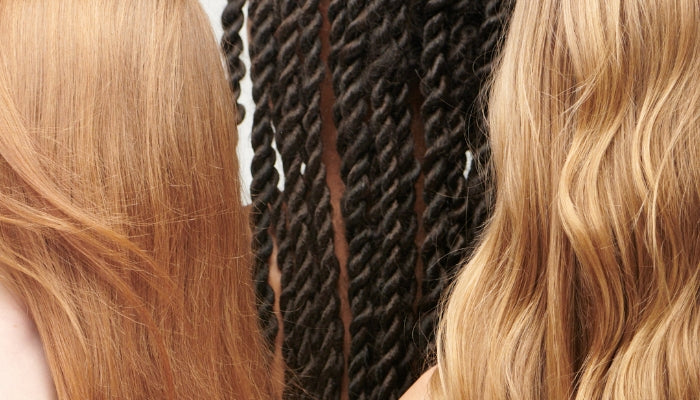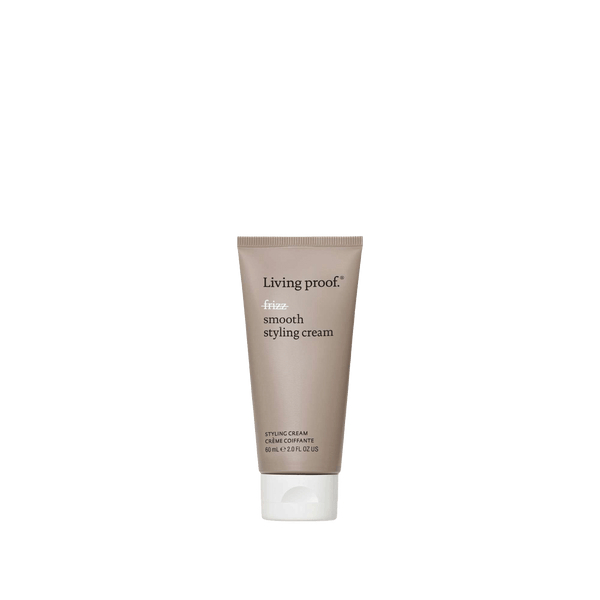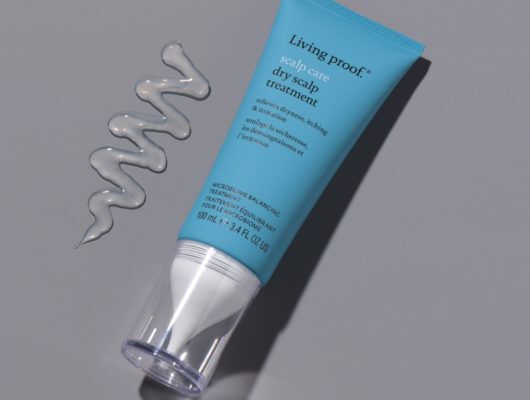How to Restore + Repair Damaged Hair

There are many causes and common signs of damaged hair — some obvious, some not — that can lead to numerous concerns over time, be they frizz, hair breakage, or a dull or rough texture. It’s essential to know how you can offset hair damage to keep your hair at its healthiest. Doing so can offer visible benefits in the long run.
Want to learn how to fix damaged hair? Our guide will provide you with a variety of tips, tricks, and hair repair products you can use for visible improvement.

What is damaged hair?
There is an important distinction to be made between damaged hair and natural hair aging. Some common signs of damaged hair are dryness, dullness, hair that feels thick at the root and thin at the ends, increased breakage, and hair that is more tangled than usual.
Hair damage can result from mechanical stress, including brushing, pulling, and tight hairstyles. Thermal stress – flat ironing or other heat styling – and chemical services, including bleach, relaxers, perms, and hair color are also major contributors to hair damage. Knowing the root cause can determine the best way to address the problem.
When it comes to natural hair aging, one of the clearest signs is a change in color (hair begins to lighten and eventually turns white). A change in hair thickness is also considered natural. Because hair is made of many proteins — with a single strand’s average life between two and seven years — it is constantly being replaced, and the rate at which that happens slows over time.
Types of hair damage
Hair damage is not one-size-fits-all. Consider these different variations to help pinpoint how to fix damaged hair.
- Physical damage is caused, for example, by brushing and styling, as well as using hot tools.
- Chemical damage results from coloring, bleaching or perming, and overusing hair products.
Common causes of hair damage
Styling habits, chemical treatments, and environmental influences are all contributors to haircare pitfalls. Specifically, each of the following may lead to dry, damaged hair:
- Over styling and excessive use of hot tools
- Chemical treatments and harsh hair products
- Sun exposure and pollution
- Nutrient deficiencies
How to repair damaged hair
1. Incorporate reparative ingredients
When it comes to how to repair damaged hair, it starts with finding ingredients that help to visibly reduce those signs of distress. You can rely on the key nutrients in our Restore Shampoo and Conditioner, which help repair the already damaged hair cuticle layers as well as help strengthen hair to protect it from future damage. Inside, you’ll also find conditioning agents and a mild amino acid-derived surfactant that gently cleanses hair and helps it stay cleaner longer — so you can wash it less.
To elevate your haircare routine, consider using a bond builder to strengthen strands from the inside out. Our Moisture Rescue Mask is another excellent option for repairing damaged hair, offering restorative benefits without weighing it down.
2. Stay Hydrated
Finding the right amount of moisture is a crucial step in repairing damaged hair. When hair is properly hydrated, the cuticle—the outermost layer of the hair shaft—lies flat, protecting the hair and sealing in moisture to keep strands strong.
When hair is dehydrated, the cuticle lifts, leaving hair vulnerable to further moisture loss. This can happen due to weather, harsh chemicals, certain haircare products, or over-washing—making dehydration more common than you might think.
The solution is a consistent, nourishing haircare routine. Start with a moisturizing shampoo and conditioner, and incorporate a deep conditioner once or twice a week. Our Restore Conditioner is designed for dry, damaged hair, boosting softness, manageability, and shine. For an extra treatment, try the Moisture Rescue Mask to help restore and strengthen hair from within.

3. Protect from heat
Curious about how to prevent heat damage on hair? It’s easier to prevent hair damage than to fix it, and there’s no better way to do so than by protecting hair from heat damage. Always apply a heat protectant before you do any heat styling, using a blow dryer, curling iron, or flat iron. A good heat protectant spray acts as a barrier between the hot tool and your sensitive strands, offering heat protection up to 450 degrees Fahrenheit and adding shine. Just make sure you know how to use heat protectant spray so that you protect your strands while trying new hairstyles.
When you’re using a flat iron, curling iron, or blow dryer, it’s also important to limit your hair’s exposure to heat. Don’t apply heat to the same section of hair repeatedly, and keep the temperature at the lowest possible setting. Cut back drying time by letting your hair air dry a bit before blow-drying, and use a powerful blow dryer that dries the hair quickly.
It’s crucial to lower the setting on your styling tools when possible. Heat damage of hair begins at much lower temperatures than 450 degrees Fahrenheit. In fact, proteins in hair can begin to change shape at 284 degrees, resulting in a loss of elasticity. Look for styling tools with variable temperature settings and dial down the heat.
4. Invest in frequent trims
Split ends and brittle hair are a dead giveaway of hair damage, so snipping them off with regular trims will keep hair looking as healthy as possible while you’re incorporating a new haircare routine.

5. Avoid certain treatments
Bad news: The chemicals used in hair color products, especially bleach, can be extremely harsh on your hair. If you’re actively trying to reverse chemical damage, try to avoid coloring or relaxing your hair — or getting hair extensions, which can pull and break the bonds of your natural hair strand. This doesn’t have to be forever, but an extended break from hair dye and other harsh chemicals can help restore hair’s health.
Then, once you’re ready to get back to it, use the Restore collection or a bond builder that helps repair all three types of hair bonds to help offset chemical damage from those treatments. (It’s safe for use on color-treated hair.) To give any of your damaged hair some extra love, use a hair repair treatment that will not only make your hair feel but look healthier after use. Try our Clarifying Detox Shampoo to gently, yet effectively, remove buildup from product, pollution, and hard water.

6. Add protection
Between UV exposure and air pollution, the great outdoors can, incidentally, lead to dry damaged hair. Remember to wear a hat or scarf for initial protection. Additionally, you can help prevent UV ray hair damage by moisturizing your strands with a nourishing product like our Restore Repair Leave-In conditioner. This conditioning leave-in hair treatment will defend hair against the damaging effects of UV rays, help prevent up to 93% of new damaged ends typically caused by styling, and significantly strengthen hair, leaving it 15 times stronger after just one use.
7. Consider a shower head filter
Another preventative measure you can take to revive your damaged hair is investing in a shower head filter that filters out minerals, such as chlorine and heavy metals. These can leave a film on hair as you rinse, which can prevent moisture from adequately penetrating the hair strand.
Fortunately, it’s easy to address — simply switching out the shower head. A shower head with a filter can help remove these minerals to leave your hair looking and feeling healthier and promote a healthier scalp. Additionally, you can use a strong clarifying detox shampoo to help remove buildup from hard water.

8. Detangle gently
Start detangling in the shower. Use a wide-tooth comb or a detangling brush while your conditioner is still in your hair. Wet hair is particularly prone to damage because the bonds that form between the hydrogen from water molecules and the protein in your hair are weaker than the protein-to-protein bonds of dry hair. This means the hair can more easily stretch and break when it is wet.
When you get out of the shower, avoid roughly drying your hair with a towel. Instead, invest in a microfiber towel and gently squeeze excess water from your hair. The goal is to keep fibers aligned and minimize pulling and stretching.
Spray damp hair with a nourishing product like the Restore Perfecting Spray, which uses a blend of a cationic detangler and a slip-enhancing polymer to keep hair soft and smooth. The formula includes plant- and marine-derived active ingredients that offer both UV and thermal protection — so you can receive almost everything your hair needs in one product.
9. Maintain a healthy scalp
When it comes to figuring out how to fix damaged hair, you may be curious about the best way to maintain a healthy scalp. After all, your scalp is the foundation at which your hair grows and also needs love and care from time to time. If you notice dry flakes falling from your hair, you’ll want to learn how to moisturize your scalp to make sure it can keep your hair healthy as it grows.
Consider trying a dry scalp treatment that helps rebalance your scalp’s natural foundation and delivers instant and sustained hydration through its hyaluronic acid-based formula. You can also add a revitalizing hair scalp treatment to your haircare routine. You’ll see and feel the difference of healthier hair.
10. Opt for silk or satin pillowcases
Avoid damaged hair while you sleep by opting for a silk or satin pillowcase. The smooth texture minimizes friction and hair breakage against your pillow, also meaning fewer tangles to brush through. Because satin is less drying than cotton, which typically makes up pillowcases, you’ll avoid frizzy damaged hair and retain your hair’s natural moisture.
Hair Damage FAQs
Can damaged hair become healthy again?
Put simply, yes. Start by identifying what’s causing stress to your hair—heat styling, chemical treatments, or environmental factors. Then choose products that address those specific needs. For example, frizz and dryness are often signs that your hair needs intense hydration. Using Living Proof’s Moisture Rescue Mask regularly can help restore moisture, smooth the cuticle, and strengthen strands, leaving hair more manageable and healthy-looking over time.
How long does it take to repair damaged hair?
Results will vary by person. But start now, with this guide, and you’ll be well on your way to healthy hair. Take a hard look at your habits and products to identify what’s causing issues, then take action to eliminate the frizz, split ends, and breakage.
How can I prevent further hair damage?
Besides the day-to-day routines that may be pulling, stretching, or breaking your hair, using reliable, professional products with proven ingredients will prevent further hair damage.
Does perming your hair damage it?
Any process that involves harsh chemicals, like perming or bleaching, will damage hair by breaking naturally occurring bonds. Offset those methods by learning how to strengthen hair and what products to rely on.
Does washing your hair everyday damage it?
There is no singular answer to this question. Instead, hair texture, styling routine, exercise, and other factors play a role in what is best for your hair. However, hair that undergoes frequent washing can overproduce oil.
How do you repair severely damaged hair?
Severely damaged hair requires proven treatment. Our Triple Bond Complex is a weekly, leave-in treatment and hair mask that will leave your hair that’s as good as new after one use*. It also prevents future damage by building covalent bonds and others often broken by heat, styling, color, and chemical treatment.
*Based on technical measurements of keratin structural integrity
With consistent care, you can restore your hair’s health and vitality. Remember, the first step is to take stock of habits that may be damaging your hair, then find scientifically-proven products that will do the work to fix damaged hair. Try the tips and techniques provided here to begin your journey to healthy hair.
Need some more help finding your perfect haircare routine?
Resources
- https://www.allure.com/story/8-reasons-your-hair-is-breaking-off
- https://www.medicalnewstoday.com/articles/325026#causes
- https://www.medicalnewstoday.com/articles/325026#causes
- https://food.ndtv.com/beauty/hair-care-eat-these-10-foods-to-revive-your-dull-locks-2014844
- https://casper.com/blog/silk-pillowcase-benefits/
- https://www.healthline.com/health/egg-yolk-for-hair
- https://www.essence.com/hair/transitioning/ways-beer-benefits-your-transitioning-hair/#168959
- https://www.shape.com/lifestyle/beauty-style/hair/coconut-oil-for-hair
- https://www.marieclaire.com/beauty/olive-oil-for-hair/
- https://parade.com/1304956/shelby-deering/home-remedies-for-damaged-hair/
- Tags: Hair Health How To











